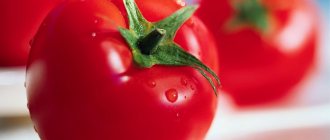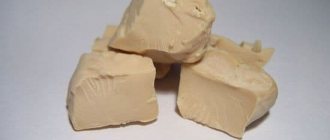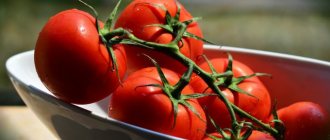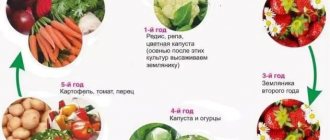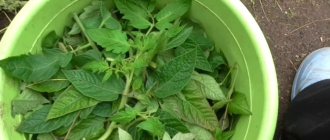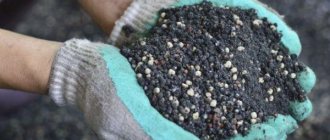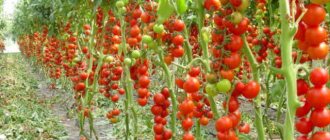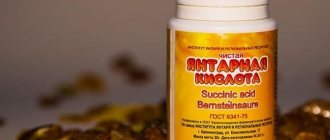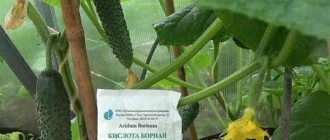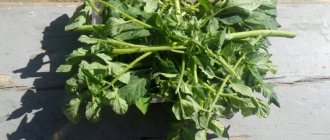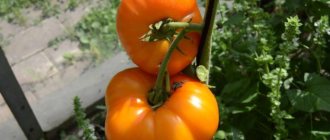Category: Mineral fertilizers Reading time: 9 min · Views: 6,725
Agrochemical fertilizers are widely used in gardening and horticulture. Today we will look at potash fertilizers, in particular potassium chloride and calcium. We will also consider what can replace calcium chloride when fertilizing the soil in the garden or caring for house flowers.
What is calcium for?
Tomatoes simply need calcium chloride during the period of growth and flowering. It is involved in photosynthesis and promotes the production of carbohydrates. Without it, the plant does not receive normal nutrition, it does not have enough strength to grow foliage and flower.
The need for a calcium supplement manifests itself even at the stage of seed germination. During this period, the sprouts develop due to the supply of nutrients in the seed itself, but as soon as these reserves are depleted, the seedlings are fed.
Tomatoes growing on acidic podzolic soils need calcium more than others. This substance reduces the negative effects of excess aluminum, manganese and iron in the soil. If there is a shortage of such an element in the soil, the roots of the bush are the first to suffer. Their growth stops, root hairs begin to lose their ability to absorb moisture and nutrients dissolved in it. Even with normal watering, the bush withers and turns yellow.
Applications of potassium chloride
What is potassium chloride used for? The main direction of use is the fertilization of cultivated vegetation in the form of an independent element and in combination with other minerals. The use of potassium chloride in agriculture is optimal for soil of any structure due to its good and rapid solubility.
What is the benefit of potassium chloride as a fertilizer?
It is not for nothing that the element potassium is prescribed in medicine to maintain heart function. In plants, it performs vital functions during the growing season, having a different effect at each stage.
- Normally, potassium chloride allows plants to acquire and develop immunity to low temperatures, temperature changes, and also resist pests or viruses during any period of growth and development.
- The root system develops better, which allows the above-ground part to receive the required amount of moisture and nutrients, and its conductivity increases.
- The plant rejuvenates annually, increasing young shoots and green mass.
- Allows you to obtain high yields and improves taste.
- Significantly increases the aging time of harvested fruits.
As a fertilizer, potassium chloride is applied from early spring to mid-autumn. There is no need to do this before winter, unless you exclude heavy loams and clay areas of the garden. Fertilize the substrate with the preparation as follows:
- watering a water-potassium solution on the tree trunk urgently when symptoms of a lack of substance are detected;
- in May into the soil, followed by digging to lighten the soil composition and increase fertility;
- into the soil to strengthen the immune system of perennials before wintering;
- seasonal fertilizer of plants from June to August in the form of root and leaf feeding, as well as in combination with other chemical compounds.
Application must be carried out in accordance with the instructions and standards for each crop.
Symptoms of calcium deficiency
The lack of calcium chloride in tomatoes primarily affects young shoots.
The growing points gradually die off, and the shoots themselves become thinner, become sluggish and drooping. If the deficiency manifests itself at the stage of formation and ripening of fruits, brown dry spots may be observed on them.
Sometimes the symptoms of calcium deficiency are confused with manifestations of late blight, but in this case, to eliminate the problem, it is enough to feed the bushes. Cone-shaped tomatoes are more susceptible to the disease than others. Top rot quickly spreads to the entire fruit, making it unfit for consumption. Affected tomatoes differ significantly from healthy ones. They are drier and do not produce seeds.
Symptoms of element deficiency are:
- lethargy of leaves and shoot tips;
- frequent branches breaking;
- long fruit ripening;
- lightening and curling of leaves.
Signs of calcium deficiency in tomatoes
Calcium deficiency in soil due to natural causes is unlikely. Many gardeners add substances containing this element to the soil - lime, ash, dolomite. But its absorption by plant tissues, including tomatoes, is prevented by excessive fertilization of the soil with nitrogen fertilizers, even such as manure and bird droppings. Its shortage can also be caused by violation of the rules for applying fertilizers based on potassium and manganese.
Another reason for calcium imbalance in tomatoes is their insufficient watering. For root nutrition of plants, it is available in the form of the Ca2+ cation. Tomatoes receive it along with water and send it to areas of consumption (leaves and fruits). In addition, overdrying the soil leads to damage to the root system, which further aggravates the situation.
Attention! Calcium deficiency in tomatoes is more likely to be due to water stress than to low calcium levels in the soil.
If there is not enough element in the tomato cells, the pectin substances in them swell, the walls become slimy, and the plant begins to rot.
By changes in the condition of the bush organs, a calcium deficiency can be diagnosed:
- Roots. The roots of tomatoes are the first to suffer from calcium deficiency. The process of their development slows down, they degrade and rot.
- Leaves and shoots. Calcium starvation manifests itself in a decrease in the size of young leaves, their deformation, the appearance of chlorotic spotting and the subsequent death of the plant. The edges of the leaf blades curl and look “scorched.” Mature leaves acquire a richer dark green hue and increase in size. The tops of the shoots lighten and gradually die off. The flowers on the bush fall off.
- Fruit. When growing tomatoes, the most informative sign of calcium deficiency is blossom end rot that occurs on the fruit. Initially, it appears in the form of dark gray spots on their tops. Gradually the defect spreads over a large area.
Top rot is intensified by factors such as increased temperature and humidity, and soil salinity. This situation leads to the loss of a significant part of the tomatoes.
Important! Blossom rot is not an infectious disease of tomatoes, but a consequence of calcium deficiency. Tomatoes growing in open ground and in greenhouses are susceptible to it. One of the preventive measures is compliance with the watering regime.
How to fertilize
Fertilizing the soil with minerals is carried out during autumn or spring digging. The procedure is repeated every year, as the nutrient reserves of the soil are depleted.
The plant needs feeding
To fertilize tomatoes, add the following to the soil:
- Dolomite flour. It consists of limestone ground into powder and may contain a small amount of impurities: clay and sand. It is also effective for neutralizing acidic soils. Its components are capable of binding radionuclides, which makes it possible to grow an environmentally friendly vegetable. Dolomite flour is added to the soil at the rate of 500-600 g per 1 m²; for highly acidified soils it will require 2 times more.
- Slaked lime is less commonly used for feeding tomatoes, but is no less effective. The difficulty of applying it is that it can burn the roots and trunk of the bush in direct contact with it, so fertilizer is applied only in the fall in an amount of 500 g per m². On loam, the dosage is increased to 800 g.
- Chalk is applied to the soil in ground form. The fertilizer has a high content of calcium carbonate. In spring or autumn, about 300 g per m² is applied.
All these substances do not dissolve in water, and this must be taken into account when digging. The lumps are broken up with a shovel or rake to distribute the fertilizer evenly.
Calcium nitrate
Unlike other mineral fertilizers, calcium nitrate can be used to fertilize tomatoes during any period of their growing season. Calcium nitrate is highly soluble in water and is quickly absorbed by plants.
The calcium variety of nitrate should not be applied to the soil at the same time as phosphorus and sulfur fertilizers: this negatively affects metabolic processes in the plant and reduces the percentage of calcium nitrate consumption. Tillage is carried out for the first time at the stage of growing seedlings. This guarantees:
- normal development;
- increase in yield by 10-15%;
- resistance to temperature changes and drought;
- higher resistance to various viruses and fungi;
- rich taste of tomatoes, as well as good presentation.
For 20 g of calcium nitrate, take 100-120 g of sifted wood ash, 10 g of urea and 10 liters of water. Water the tomato seedlings with this solution at the root, avoiding contact with the stems and leaves: this can cause burns.
Folk remedies
Calcium deficiency can be compensated for using folk remedies.
To do this, 200 g of wood ash is boiled in 3 liters of water with 30 g of crushed eggshells. Boil the mixture for at least an hour over very low heat. There is no need to add boiled liquid.
After cooling, seedlings or adult plants are sprayed. Treatment should be carried out in dry weather, as precipitation will make spraying useless. To make the solution stick better to the leaves, you can add laundry soap to it.
Agrochemical fertilizers are widely used in gardening and horticulture. Today we will look at potash fertilizers, in particular potassium chloride and calcium. We will also consider what can replace calcium chloride when fertilizing the soil in the garden or caring for house flowers.
Rules for using fertilizers
Advice! Before fertilizing, to quickly absorb calcium, tomato bushes are well watered.
High results are achieved by simultaneous root and foliar application of calcium-containing fertilizers.
- Root feeding. Dry or liquid concentrated fertilizers are diluted in water, according to the instructions, and watered at the roots of the tomatoes. It is important to follow the watering rules. The best time for this procedure is early morning. Preventive method - dry calcium-containing fertilizers are distributed between rows, sprinkled under the roots or applied when digging the soil.
- Spraying tomatoes. The first spraying of bushes with calcium-containing fertilizers is carried out 7 - 12 days after planting the seedlings in the ground. Foliar treatment will be carried out in cloudy, windless weather.
Attention! Spraying tomatoes growing in a greenhouse should not be overused. High air humidity provokes the development of diseases. After treating the plants, the greenhouse should be well ventilated.
When working with fertilizers, there are general requirements given in the table that must be met in order not to harm the plants:
| Fertilizer | Application requirement |
| Calcium nitrate | To prevent the accumulation of nitrates in fruits, the drug should be used strictly according to the instructions. |
| Kalbit S | do not combine with the application of phosphorus and sulfur fertilizers. |
| Brexil calcium | do not mix with other calcium-containing fertilizers; the consumption rate (especially for greenhouses) should not exceed 150 g per 100 liters of water. |
| Limestone and dolomite flour | do not combine with ammonium nitrate, superphosphates and urea. |
| Slaked lime | work using personal protective equipment (goggles, gloves, gauze bandage). |
They recommend a set of preventive measures against calcium deficiency in tomatoes:
- follow the watering schedule, do not allow the earthen ball to dry out;
- After moistening, the soil must be loosened;
- on hot days, shade the tomatoes;
- apply fertilizers regularly;
- apply foliar and root feeding in combination;
- To increase the immunity of tomatoes, use growth stimulants.
The benefits of potassium supplements
This microelement ensures the proper development of plants: it accelerates the movement of nutrients in tissues and participates in the formation of the root system. Potassium also has an important effect on the quality of fruits: it improves taste, color and size. Potatoes especially need potassium; without it, they do not acquire a sufficient amount of starchy substances.
Sugar beets also urgently need potassium, since if it is deficient, the root crop cannot accumulate enough sugar. Vegetable and fruit crops accumulate monosaccharides thanks to potassium. At the same time, their taste characteristics improve.
Note! If nitrogen is needed for vegetation, then potassium is needed for the formation of tubers and fruit set.
A sufficient amount of this microelement in the soil strengthens the immune system of seedlings, protects against phytofungi and other lesions. Potassium also develops the resistance of seedlings to unfavorable climatic conditions and drought.
Signs of potassium deficiency in the soil:
- stop in growth and development;
- deformation of leaf shape;
- infection by fungal diseases;
- stunted appearance of seedlings;
- faded and dried leaves;
- blue-green leaf color;
- uneven ripening of fruits.
It is very easy to notice a lack of potassium: old leaves begin to dry out at the edges and turn brown. They quickly wither and fall off.
The use of special calcium-containing fertilizers in the nutrition of vegetable and fruit crops
Adequate plant nutrition is not only one of the main factors for a high yield of high-quality products, but ultimately it is adequate nutrition and health for people. Basic root nutrition programs are developed for each crop separately and depend on many factors, but intensive technology for cultivating vegetable and fruit crops is impossible without foliar feeding.
Foliar feeding in intensive technology is one of the most important elements of the strategy for controlling growth and production processes in a plant. The most powerful tool for operational influence on the processes that determine the harvest and its quality.
Practice shows that it is the combination of foliar feeding and fertigation (or root nutrition) that allows you to most fully reveal the potential of productivity while simultaneously increasing quality indicators. The synergistic effect of these techniques is proven and undeniable. In this case, special attention should be paid to those essential nutrients that are not recycled in the plant body, but are constantly needed by young and growing organs and tissues. Here a special role belongs to Calcium.
For many vegetable and fruit plants, the removal of calcium per unit yield is comparable to the removal of nitrogen, and crops such as watermelon, pumpkin, cabbage and Chinese cabbage, apple trees, pears and grapes consume even more calcium than nitrogen.
Average removal of nutrients (kg/t) by vegetable and fruit crops, including vegetative mass (stems, leaves). FAO standards
(“Modern vegetable growing in closed and open ground”, Belogubova E.N. et al. Zhitomir, “Ruta”, 2007)
| Culture | Nitrogen N | Phosphorus P2O5 _ _ _ | Potassium K2O _ _ | Calcium CaO | Magnesium MgO |
| Cucumber | 3,0 | 2,0 | 4,5 | 3,0 | 1,5 |
| Tomato | 3,2 | 1,2 | 5,8 | 2,0 | 0,5-0,7 |
| Sweet pepper | 4,0 | 2,2 | 5,2 | 3,5 | 1,0 |
| Cabbage | 5,5 | 3,0 | 7,5 | 7,0 | 1,0 |
| Cabbage | 5,0 | 2,5 | 7,0 | 6,0 | 1,0 |
| Carrot | 4,3 | 1,8 | 6,7 | 4,3 | 0,7 |
| Beetroot | 6,0 | 2,0 | 12,0 | 5,0 | 2,0 |
| Watermelon | 1,83 | 0,75 | 3,17 | 3,0 | 1,0 |
| Pumpkin | 1,0 | 1,1 | 2,0 | 1,5 | 0,5 |
| Apple tree | 2,57 | 0,94 | 3,72 | 3,5 | 0,38 |
| Pear | 2,8 | 0,6 | 3,2 | 3,0 | 0,4 |
| Grape | 4,67 | 2,33 | 7,66 | 5,1-8,0 | 1,0-1,6 |
Calcium is one of the necessary structural and potential-forming elements with certain specific functions. It is responsible for the structural and physiological stability of cells and tissues, enhances metabolism in plants, affects the activity of enzymes and the conversion of nitrogenous substances, plays an important role in photosynthesis and the movement of carbohydrates, affects the physicochemical state of protoplasm - its viscosity, permeability and others properties on which the normal course of biochemical processes depends.
Calcium has a beneficial effect on root growth and plays a major role in reducing the toxic effects of excess other elements, including ammonium, manganese and aluminum ions. By delaying the excessive entry of some elements into the cell, it at the same time stimulates the absorption of others that are missing.
With a normal level of calcium nutrition, nitrogen absorption increases 2-3 times. In plants well supplied with calcium, auxin synthesis is enhanced, and plant resistance to the stressful effects of pesticides and other negative factors increases.
The main calcium-containing fertilizer in fruit and vegetable growing of both open and protected soil is calcium nitrate (synonyms: calcium nitrate, or calcium nitrate). The optimal balance of calcium in the nutrient solution ensures normal growth and development of the plant, but cannot prevent the occurrence of physiological calcium deficiency in juicy fruits , because this element is not reutilized in the plant organism and does not move well with the ascending current into young organs and tissues. In juicy fruits, 90% of calcium is localized in cell walls, membranes and intercellular plates - lamellae, where calcium compounds with pectin substances “glue” the cell walls together. During the period of fruit growth, active cell division occurs, which requires additional calcium for the formation of new cell walls. At the same time, in parallel, the amount of moisture consumed increases, which naturally reduces the concentration of calcium in localized areas, causing physiological deficiency and weakening adhesive functions. As a result, the growing point of the cucumber may die, the leaves lose turgor and become dome-shaped, and the fruits do not have sufficient hardness. In tomatoes, peppers, eggplants and watermelons, the ovary may fall off, and on the fruits, due to intercellular gaps in places of intense cell division, where infection subsequently penetrates, blossom end rot develops.
Death of the growing point and dome-shaped leaves of cucumber with acute calcium deficiency.
Blossom rot on tomato, eggplant and sweet pepper fruits due to calcium deficiency.
Even a slight excess of moisture during this period leads to tissue rupture and cracking of cabbage heads, carrots and beets, as well as cherries, plums, apricots, nectarines, tangerines, currants, gooseberries and grapes. In potatoes, cracking of the tuber may occur in the early phases, which impairs its marketability, but it is worse when intercellular breaks occur inside the tuber in the final phases of growth, which does not spoil the appearance, but leads to browning of the pulp at the break points and the further development of dry or wet bacterial rot during storage. Similarly, apples develop bitter pitting.
Physiological calcium deficiency leads to large losses of the economic part of the harvest of vegetable and fruit crops. This disease is not pathogenic in nature, so fungicides cannot solve this problem. Preventing the development of deficiency is possible only with the help of periodic foliar feeding of plants throughout the entire fruiting period, which allows calcium to be effectively delivered to the places of greatest need. If calcium nitrate is mainly used for fertigation, then for foliar feeding, as a rule, specialized forms of calcium that do not contain nitrogen are used. There are a lot of water-soluble calcium-containing substances, but not all of them are suitable for such intake. These chemicals can be roughly divided into two main groups:
Inorganic salts (calcium sulfate and carbonate are a priori not suitable for this)
— Calcium chloride ( CaCl2 ) is not a fertilizer; high chlorine content can cause phytotoxicity, leaf necrosis, rust, etc. (the chemical is not registered as a fertilizer, but some farmers use it because it is cheap);
— Calcium nitrate ( Ca ( NO 3 ) 2 ) – a high nitrogen content is undesirable during the period of fruit filling, it impairs the quality, and stimulates vegetative growth. Physiologically alkaline fertilizer - concentrations above 1% cannot be used.
2. Organic compounds
— Calcium chelate Ca (EDTA) – low stability of the compound in light and in water with pH > 6.5, there is a risk of phytotoxicity. Excess leads to subcutaneous “golden spot” of tomato formed by calcium oxalates;
— Calcium complexes with amino acids or lignosulfonic acid Ca ( LSA ) – high stability of the compounds and a high degree of calcium absorption. There is no risk of phytotoxicity.
Ca ( LSA ) compounds containing 20% CaO, which stimulates the movement of calcium through tissues and improves its absorption. Such agrochemicals include well-known brands of foreign and domestic production - Kalbit S, Brexil Ca, Kaos HT and AgroBor Ca. In Russia, such special fertilizers appeared and began to be actively used since 2004.
Experiments on cherries in the orchard of JSC “showed the high effectiveness of the use of calcium-containing agrochemicals. The layout of the trees in the garden is 7 x 4 m, the age of the plantings is 8 years. The soil tillage system between the rows is natural grass with periodic mowing; in the row zone there is herbicidal fallow. There is no irrigation.
Ca( LSA ) treatments were carried out against the background of heavy rainfall. The first feeding is at the beginning of fruit growth. The rest of the treatments - immediately after the rain, as soon as the leaves and fruits dry. A total of 4 feedings of 1 l/ha were carried out.
During the period from fruit filling to harvesting, 153 mm of precipitation fell, 83% more than the average long-term data, which led to cracking of the fruit.
Efficiency of using agrochemical Ca( LSA )
in cherry plantations, in the Kuban horticultural zone
(garden, enterprise “Vyselkovskoye” JSC “, 2007)
Cherry yield, t/ha
| Variety | Biological yield, t/ha | Economic yield, t/ha fruits without damage | ||
| Control | Option | Control | Option | |
| Large-fruited | 12,2 | 12,2 | 3,0 | 10,9 |
| Daibera black | 11,7 | 11,7 | 3,6 | 10,8 |
| Franz Joseph | 10,5 | 10,5 | 6,0 | 10,2 |
Quality indicators of cherry fruits
| Variety | Damaged, cracked fruits, t/ha (as a percentage of biological yield) | Fruits without damage, t/ha (as a percentage of biological yield) | ||
| Control | Option | Control | Option | |
| Large-fruited | 9,2 (75,0%) | 1,3 (11,0%) | 3,0 (25,0%) | 10,9 (89,0%) |
| Daibera black | 8,1 (69,0%) | 0,9 (6,8%) | 3,6 (31,0%) | 10,8 (93,2%) |
| Franz Joseph | 4,5 (43,0%) | 0,3 (2,6%) | 6,0 (57,0%) | 10,2 (87,4%) |
Costs, revenue and profit per unit area of a cherry orchard
| Variety | Control | Option | Profit from 1 ha, rub. | |||
| Costs per 1 ha, rub | Revenue from 1 ha, rub | Costs per 1 ha, rub | Revenue from 1 ha, rub | Control | Option | |
| Large-fruited | 80 000 | 210 000 | 161 000 | 763 000 | 130 000 | 602 000 |
| Daibera black | 86 000 | 252 000 | 133 000 | 756 000 | 166 000 | 502 000 |
| Franz Joseph | 110 000 | 420 000 | 154 000 | 714 000 | 310 000 | 560 000 |
The use of calcium-containing agrochemicals, even not in the highest dosages, is agronomically and economically effective. Especially on varieties that are not resistant to fruit cracking. The cost of purchasing and applying fertilizer amounted to about 2,000 rubles per 1 hectare, and profits increase by 250,000 - 472,000 rubles per 1 hectare. The density of the skin of cherry fruits is greater, the fruits crack less, and the quality of the harvest is higher.
Scientific experiments on open ground tomatoes also showed the high efficiency of the agrochemical. Thus, three times foliar feeding with an interval of 15 days from the formation of the ovary of hybrid tomato plants General F1, with a special fertilizer containing Ca ( LSA ) in dosages of 0.5 - 1.0 l/ha, contributed to the enhancement of growth processes and photosynthesis, which had a positive effect on the formation of fruits and their quality. As a result, there was an increase in the diameter and weight of the fruit, depending on the dosage, by 0.4-1.1 cm and 11-34 g, respectively. The content of sugars increased by 0.2-0.5%, vitamin C - by 3.3-8.1 mg/100 g of raw material. The increase in fruit yield was 24.5-35.8 c/ha or 8.7-12.7%, with the yield in the control being 280.9 c/ha (KubSAU, 2012). It should be noted that the extreme weather conditions of 2012 were generally unfavorable for all agricultural crops, incl. and for tomatoes.
In 2021, an agrochemical containing Ca ( LSA ) was tested by the Republican Unitary Enterprise “Institute of Soil Science and Agrochemistry”, Minsk, on the basis of Ozeritsky-Agro OJSC, Smolevichi district, Minsk region, on the Makhitos F1 tomato grown in a greenhouse on a mineral wool substrate. The seedlings were planted on mineral wool on July 12, 2017, with a planting rate of 2.5 plants per 1 m2. The area of the recording plot was 56.8 m2, the location of the plots was randomized, the repetition was fourfold, there were 2 options. The experimental design was as follows:
Standard - Nutrition technology used at Ozeritsky-Agro OJSC, based on a low-volume method on a mineral wool substrate - drip irrigation system with a compensated dropper (without treatment with the tested fertilizer) - background.
Tested fertilizer – Background + 1st fertilizing in the flowering phase of 1-3 brushes Ca( LSA ) - 1.3 l/ha + 2nd fertilizing in the flowering phase of 4-6 brushes with fertilizer Ca( LSA ) - (1.3 l /ha) + 3rd fertilizing in the flowering phase of 6-12 brushes with Ca ( LSA ) - (1.3 l/ha).
The agrochemical was used in the form of foliar fertilizers - the 1st treatment was carried out on 08/03/2017, the 2nd treatment - on 08/17/2017, the 3rd treatment - on 09/01/2017. Yield recording with the selection of tomato fruits to determine quality indicators was carried out three times – 09/26/2017, 10/09/2017 and 10/19/2017. Fruit collection was carried out by greenhouse employees in the usual manner. There were no side effects from the use of the studied fertilizer.
The quality of tomato fruits was determined by the following indicators: mass concentration of dry substances in solution in terms of sucrose and nitrate content, for each of three selections. The use of fertilizer with Ca(LSA) as a foliar fertilizer led to an improvement in the quality of tomato fruits in terms of this indicator. Thus, in the first selection there was a tendency to increase, and in the second and third selections there was a significant increase in sugar content by 0.4°Bx compared to the standard. The nitrate content in all experimental variants for all selections complied with the sanitary standards adopted in the Republic of Belarus and was in the range of 14.1-127.0 mg/kg wet weight, with the MPC for nitrates equal to 150 mg/kg wet weight. It should be noted that there were higher values for this indicator in the reference variant in the first two selections (Table 1).
Table 1 – Indicators of the quality of tomato fruits Makhitos F1 at Ozeritsky-Agro OJSC, Smolevichi district, Minsk region, 2017.
| Options | Mass concentration of sugars, degree Brix | Nitrate content, mg/kg wet weight | ||||
| 1st selection | 2nd selection | 3rd selection | 1st selection | 2nd selection | 3rd selection | |
| 1. Standard – Tomato nutrition technology used at OJSC “Ozeritsky-Agro” – Background | 4,8 | 4,2 | 4,4 | 127,0 | 66,6 | 16,1 |
| 2. Background + three fertilizing with fertilizer with Ca( LSA ) 1.3 l/ha | 5,1 | 4,6 | 4,8 | 96,0 | 20,1 | 19,2 |
| NSR05 | 0,28 | 0,26 | 0,25 | – | – | – |
| MPC for nitrate content 150 mg/kg wet weight | ||||||
The effect of agrochemical Ca( LSA ) on tomato fruit yield is shown in Table 2.
Table 2 – Fruit yield of Makhitos F1 at Ozeritsky-Agro OJSC, Smolevichi district, Minsk region, 2021.
| Options | Productivity, kg/m2 (amount for three selections as of October 19, 2017) | |
| when cleaning | increase to the standard | |
| 1. Standard – Technology used at OJSC “Ozeritsky-Agro” (without treatment with the tested fertilizer) – Background | 6,13 | – |
| 2. Background + three fertilizing with fertilizer with Ca( LSA ) 1.3 l/ha | 6,72 | 0,59 |
| NSR05 | 0,308 | |
At OJSC “Ozeritsky-Agro”, the total yield obtained for three selections from September 26, 2017 to October 19, 2017 was 6.13 kg per 1 m2 of greenhouse. Three-fold foliar feeding of vegetative tomato plants with the tested liquid fertilizer containing Ca(LSA) at a dose of 1.3 l/ha against the backdrop of the use of tomato cultivation technology adopted by Ozeritsky-Agro OJSC provided a significant increase in tomato fruit yield by 0.59 kg/ m2 (+9.6%) in relation to the standard, and amounted to 6.72 kg/m2, while there was an improvement in fruit quality indicators in terms of sugar content.
Periodic foliar feeding with a special calcium-containing agrochemical containing Ca (LSA) during the entire period of growth and fruit filling, against the background of complete root nutrition, including and calcium nitrate, avoid losses of the economic part of the crop, increase the yield of marketable products and their competitiveness in the fruit and vegetable market, as they prevent the development of diseases associated with calcium deficiency, increase its content in cell walls, improve the structure of fruits and, consequently, their shelf life, keeping quality, transportability, presentation and quality.
Candidate of Agricultural Sciences, leading specialist of an agrochemical company
Khoroshkin A.B.
Krasnodar region
see also
Plant protection products, fertilizers
EPAA-10 - features of biological adhesive 11/12/2018
Innovation and Science
Innovations from Alliance Tire Group for agriculture 11/12/2018
Potassium chloride
Chlorine is also beneficial for plants, although its content in the soil must be strictly adjusted. Without chlorine, photosynthesis is disrupted, plant leaves quickly dry out and fall off, and suffer from chlorosis.
Potash fertilizers with chlorine can be different:
- potassium chloride;
- potassium chloride electrolyte;
- 40% mixed potassium salt;
- raw potassium salts.
The chlorine content in potassium fertilizers negatively affects many vegetable and berry crops, so I use the fertilizer only for autumn plowing of the site. Recommended soils for autumn plowing: clay, loam. Fertilizing the soil in autumn will not harm the plants, since chlorine will be washed out of the fertile layer during the winter. On sandy soils, potassium chloride is applied in the spring.
Note! Chloride fertilizers are useful for fodder and sugar beets, asparagus and celery.
Potassium chloride (KCI) is a free-flowing white powder or granules. Sometimes the granules are of a different color: this depends on the addition of additional substances to the agrochemical. In the garden it is better to use granular powder; it is absorbed faster by the soil. This powder is especially useful for chlorine-intolerant crops, as it is quickly washed out of the soil.
Instructions for using calcium supplements
Fertilizing allows you to activate metabolism in plant organisms, increase their level of resistance to fungal diseases, and regulate the acid-base balance in cells. This chemical element helps to better absorb nitrogen contained in the soil. Fertilizers with it also help crops withstand sudden temperature changes and negative environmental factors, which is especially important for perennial plantings.
Use compositions with a high concentration of calcium before planting seed raw materials in the soil to speed up the germination process. This becomes possible due to the activation of enzyme activity.
Effect on plants
Calcium in fertilizers helps improve soil health by saturating it with nutrients, resulting in:
- the vital activity of beneficial microorganisms increases;
- soil acidity decreases;
- the processes of ammonification and sulfur oxidation are accelerated;
- the fertile layer is better formed;
- the process of decomposition of organic substances in the earthen mixture is accelerated;
- the harmful effects of manganese, iron, aluminum are reduced by neutralizing their excessive amounts.
Considering that on depleted acidic sandy and sandy loam soils, part of this chemical element is washed out by water, fertilizing should be done every 5 years.
The category of plantings that have an urgent need for calcium includes: tomatoes, cucumbers, cabbage, peppers, eggplants, as well as zucchini, potatoes, pumpkin, watermelon, melon, greens, legumes, onions, and garlic. Fruit and berry plants (strawberries, strawberries, grapes, apple trees, stone fruits), flower crops (phlox, dahlias, petunias, lilies, gladioli, clematis, spring bulbs, lawn) cannot do without this chemical element.
Application of KCI in the garden
To saturate the soil with potassium, adhere to the following dosages:
- autumn: 100/200 g per square meter;
- spring: 30-45 g per square meter.
Experienced gardeners advise diluting KCI with water and watering the area. 30 g of substance is consumed per bucket. To feed the seedlings more efficiently, the total dosage is divided into three parts and the soil is fertilized three times per season.
Potato
Fertilizing a potato field must be careful, since an excess of chlorine reduces the production of starchy substances in the tubers. If the soil is sandy, it is better to replace KCI with cement dust. Heavy soils take potassium chloride fertilizer well. The potato field is fertilized during autumn plowing: 100 g KCI per m2.
Tomatoes
This crop is also sensitive to chlorine, so it should be used very carefully. The site is fertilized in the fall after clearing the crop. In spring, it is recommended to use potassium sulfate instead of KCI.
cucumbers
Potassium nutrition is necessary for cucumbers to form strong and tasty fruits. However, this crop may perceive potassium chloride negatively. Therefore, first do a test: water several seedlings with diluted agrotuc and observe the reaction. If the crop accepts the fertilizer well, irrigate all the bushes: half a liter jar per seedling.
Potassium fertilizers for cucumbers are applied 5 times per season in open ground and 3 times in greenhouse conditions. Seedlings need to be watered in pre-moistened soil: either after precipitation or after watering the beds.
Carrot
Agrofertilizer is applied when planting carrot seeds in beds. Make a deep groove (up to eight centimeters), lay down the powder and sprinkle with earth. Seeds are planted on top in the usual way. Chlorine has the ability to go deep into the soil, so its effect will not affect the condition of the seeds. The carrots will receive the necessary potassium for their development and will grow large and straight.
Fruit trees
Mature fruit trees tolerate the presence of chlorine in the soil well, so they can be safely fed with potassium chloride. One plant will require 130-150 g of agrofertilizer diluted in water. On fertile soils, less fertilizing is required (100-110 g); on sandy soils, the dosage is increased to 160-180 g.
However, use the drug carefully when fertilizing cherries, sweet cherries and apricots. These trees do not tolerate chlorine well. Pear and apple trees are conditionally tolerant to chlorine preparations. It is advisable to apply KCI after deep watering of trees or after heavy rain.
Note! Gardeners do not recommend feeding potassium chloride to the vineyard, since this plant does not tolerate chloride compounds.
Flower beds
To feed gladioli, add 15 g of agrotuk to a bucket of water - after the fifth leaf is formed. After the peduncle appears, add 20 g per bucket of water.
Peonies are fed during flowering: 10 g of powder is dissolved in a bucket of water.
Note! Chlorine negatively affects plant growth, so application rates cannot be exceeded.
Rose bushes are fed twice during the flowering period. 20 g of powder is dissolved in a bucket of water.
Dosage and application features
The autumn norm for fertilizing the soil is 100-200 g/10 m2. Spring dosage - 25-50 g/10 m2. If you want chlorine to do no harm, and potassium to reach its goal at a record pace, then prepare a solution. To do this, simply dissolve 30 g. substances in a bucket of water. The water additive is divided into parts and applied 2-3 times per season - this is more effective.
Potato
It has increased sensitivity to chlorine, reducing the percentage of starch content. Potassium chlorine is added once - in the fall (100 g/m2). On light soil, it is worth abandoning this fertilizer and replacing it with cement dust.
Tomatoes
They don't like chlorine either. Therefore, apply it by digging at the rate of 100 g/m2. In spring, potassium chloride is replaced with potassium sulfate. This will avoid negative consequences and help the plantings “take off” at the required speed.
cucumbers
Potassium is of decisive importance for cucumbers. The shortage affects not only the volume of the harvest, but also the taste of the vegetables. But excess potassium becomes detrimental to the crop. Before fertilizing all existing plants, selective fertilizing is carried out. Apply half a liter for every 2-3 plants. After 4-5 days, inspect them. If everything is in order, then feel free to fertilize the remaining beds.
In greenhouse conditions, the solution is applied twice per season, when grown in open ground - up to 5 times. It is necessary to fertilize after watering or after rain. The intervals between feedings should be approximately the same.
Fruit trees
Trees that bear fruit need potassium to survive. The presence of chlorine does not cause negative effects. One tree requires approximately 150 grams. The volume of fertilizer is adjusted depending on the soil. For example, for light soil the amount increases to 180 g, for black soil it decreases to 120 g.
Flowers
Potassium chlorine is applied 1 to 3 times during the growing season. Bulbous varieties are fertilized during flowering. Annuals and biennials, climbing plants - during the period of active growth, budding and flowering. Gladioli - after the appearance of the 5th leaf and during the formation of the peduncle. Peonies - during flowering and after the formation of the 3rd true leaf.
Potassium chloride requires certain precautions when used. If there are wounds on the skin, it prevents their healing and can cause inflammation. It is recommended to work with fertilizer wearing gloves, a respirator and goggles.
How to replace potassium chloride
In the old days there was no agricultural industry, and our ancestors got out of the situation with the help of organic fertilizers. The chlorine contained in potassium chloride is not tolerated by many plants. Also, excess chlorine greatly acidifies the soil. What contains the most potassium, and what can replace potassium chloride?
Ash is the number one fertilizer in the garden. The ash contains the maximum concentration of potassium that seedlings need. Ash can be made by burning plants, bark and tree branches.
Note! One kilogram of ash replaces 200-250 g of potassium chloride.
Ash is useful for acidified soils, as it promotes alkalization. Dry matter and ash water are used to feed the soil. Dry ash is simply dropped into the soil, and the solution is watered over the seedlings. Usually they take 200 g of ash per bucket of water, boil it for a while and let it brew for a week. The strained infusion is sprayed onto the plants or watered under the roots.
Ash performs another important function: it fights pests and treats seedlings from diseases.
Banana skin
This folk fertilizer has become widespread among gardeners. Banana skins are collected, dried and ground to a powder. To fertilize a square meter of land you will need a liter jar of dry raw materials. The powder is dropped into the ground.
Potassium sulfate
It is also called potassium sulfate. This fertilizer is completely free of chlorine and is recommended for use on highly acidic and acidic soils. Potassium sulfate protects berry bushes from harsh winters if it is added to the ground before frost. All cruciferous plants love potassium sulfate: radishes, cabbage, reps and others.
The preparation contains a sufficient amount of potassium, which promotes the accumulation of vitamins and sugar in the fruits. This increases the taste characteristics of the fruit. Potassium sulfate is also used in floriculture, since it does not contain chlorine.
Potassium chloride in the garden
Potassium chloride (like other mineral and organic fertilizers, as well as yeast, iodine, etc.), which we have used more than once in the garden for many years, remains one of the most popular components of soil nutrition. Due to the high concentration of the main active ingredient, potassium chloride is recognized as the cheapest potash fertilizer for gardeners and gardeners. Restrictions on its use in the garden and especially in the garden are associated with the negative effect of chlorine on some crops. Proper use of potassium chloride will bring maximum benefit to garden plants and avoid negative aspects.
General definition
Potassium K is one of the elements vital for plants, along with nitrogen N and phosphorus P. They are called basic because these are the three pillars on which all agriculture rests. All fertilizers based on one of these elements are called monofertilizers, and two or three in any combination are called complex fertilizers. If additional elements are added to them (copper, zinc, magnesium, etc.), they belong to the ballast group. This drug is defined in the general system as a ballast (chlorine-containing) main monofertilizer.
It is not found in nature in its pure form, but only in combination with other elements. The share of the active substance of the finished drug against the background of additional microelements averages 59-65%. In nature, the content in the soil ranges from 0.5-3%. Its greatest presence is found in clay soils, and its poorest in peat bogs.
Release form
It can be a granulate, as well as a coarse or fine crystalline powder. Usually white or pink, sometimes it has other shades due to impurities, the presence of which is not only acceptable, but also useful (if we are not talking about counterfeit).
Krupka, which is commonly called “seed”, is the highest quality form for enriching the soil. Has a prolonged effect. The powder dissolves faster than the granules, while the chlorine goes into the ground very quickly and plants that do not tolerate its presence do not suffer. And the potassium they need remains in the arable layer.
For emergency assistance and foliar feeding, it is better to use pure white powder, which carries a minimum of ballast and has the highest dissolution rate. But be careful to avoid overfeeding! Such a measure is allowed only if, due to a lack of an element, the leaves begin to turn gray between the veins and become deformed.
Advantages and disadvantages of potassium chloride over other potash fertilizers
First of all, this is accessibility and optimal migration speed in the ground. For prompt and regular fertilizing of annuals, potassium chloride is undoubtedly better than other derivatives of this pesticide.
However, the presence of chlorine ions is contraindicated for many plants, which requires its careful use. But this does not mean that this fertilizer cannot be used in areas where they grow. But this has its own instructions that require strict adherence.
Features of using potassium chloride as a fertilizer
Potassium chloride, or potassium chloride, is a potassium salt of hydrochloric acid. The use of potassium chloride is extensive: in medicine it is prescribed for K deficiency in the body, as well as for heart rhythm disorders; in construction and repair of wells - as a catalyst for drilling reactions; as a mineral fertilizer for agricultural crops. Let's look at the benefits it brings to plants.
Signs of excess and deficiency of potassium
Both have a negative impact on the growth and fruiting of crops. The ability to determine the need for a given element “by eye” is a very useful skill for any farmer.
a lack of
It is most often observed on sandstones, floodplain areas, and lowland peatlands. Plants exhibit the following symptoms:
Oversupply
As a result, green spaces begin to absorb other elements much worse, primarily nitrogen, magnesium, as well as zinc, calcium and others. External manifestations:
Why do plants need potassium?
If planting crops can somehow suffer from a lack of additional substances to the detriment of productivity (at least something will grow), then a deficiency of the main ones invariably leads to death, since this is their necessary minimum of life. At the same time, the potassium content even in depleted soils is usually enough to live “on a starvation diet,” so for a long time the replenishment of this element in agriculture was neglected. They began to use it en masse relatively recently, thanks to which it turned out that even a standard personal plot can become not only a source of some supplies for the winter, but also a good source of income for a zealous owner.
Thanks to this, this top dressing even received the popular name “market”. What can she do?
- Stimulates the growth of roots and makes them strong, due to which the nutrition of the above-ground parts is qualitatively improved and their healthy “appetite” increases.
- Increases resistance to dry weather, frost and root pests.
- The formation of young shoots is improved qualitatively and quantitatively, which means the overall yield increases.
- By increasing the fleshiness of the fruits and their sugar content, the presentation and taste characteristics are improved.
Potassium and all its derivatives are not a panacea for increasing the productivity of a plot. In order for it to “work” at its best, it requires a complete, comprehensive diet. And already against this background it gives excellent results!
Storage conditions
Usually, the instructions for use of potassium chloride contain rules that state that the substance should be kept in a dark, closed room with a low level of humidity. Otherwise, the fertilizer will turn into clods, which will make it difficult to carry out manipulations to apply it to the soil.
If the drug is stored outdoors, it is important to provide a cover for the container so that rain and dew do not erode the substance. The lid on the package must be tightly closed. The aging period specified by the manufacturer is six months, but after that you should not rush to get rid of potassium, as it retains its properties for a long time.
Potassium chloride is an inorganic fertilizer that is actively used in agriculture for vegetable, flowering, fruit, and cereal crops. Potassium chloride can act either as an independent nutritional element or in combination with other nitrogen and phosphorus mixtures. But here it should be taken into account that not all components of the complexes can be combined with potassium.
Quality of the drug, surrogates and counterfeits
The highest quality and, as a result, more expensive is granules (seeds). Due to its dense structure, it takes longer to dissolve than the powder, and the necessary potassium is retained longer in the fertile soil layer. It is obtained from the corresponding industrial waste by pressing.
Its industrial origin is not a disadvantage; on the contrary, it is considered better than natural origin. The presence of impurities can be easily determined visually using a magnifying glass. Granulates are rarely counterfeited due to the high costs of producing this form.
As for the bulk product, there is a high risk of running into a counterfeit surrogate. For bona fide manufacturers, the packaging must contain information about the origin of the waste.
Surrogates
Flotation potassium chloride
Origin: mining industry. The cheapest and most frequently falsified. In his person, there is a high risk of acquiring ground sludge, which is richer in impurities harmful to plants than in potassium. This product can only be purchased through established channels from a trusted manufacturer.
Electrolysis
Origin: electrometallurgy. The presence of harmful impurities is close to zero, since during the smelting process they go into the slag. One of the most reliable in terms of quality.
Unknown origin
Unfortunately, this is a common case. Pay attention to the color. A yellow tint of white powder or a reddish tint of pink should alert you. This means that the composition contains a lot of either sulfur or ferric iron, and maybe something else that will not bring any benefit to garden plants, but may cause harm.
If it is not possible to buy high-quality potassium fertilizer, it is better to use an infusion of wood ash.
When and how to use?
Below are described the circumstances requiring the addition of potassium chloride and predisposing to its use.
- Preparing for wintering perennial crops . Produced after harvesting before the onset of cold weather per 10 m2: heavy and medium soils - 100 g, light soils - 200 g (the lighter the soil, the more active substance is lost).
- Emergency foliar feeding . Produced when there are obvious signs of potassium starvation. Optimally - spraying with a 1-2% solution (in other cases it is undesirable due to chlorine).
- In spring on heavy soil before mulching . Consumption depends on the quality of the soil. For light soils it is better to give preference to sulfate.
- Seasonal enrichment of soil under chlorine-tolerant crops in accordance with the rules of their agricultural technology . Chloride definitely cannot be used to fertilize growing potatoes, tomatoes, lettuce and cucumbers, as well as all berries and legumes.
Adding potassium chloride during autumn digging is necessary for heavy clay soils and is better in consistently cold and snowy regions. Otherwise, over the winter, everything you need will go where the unnecessary chlorine goes.
Recommendations for individual crops
Not all gardening plants are equally in dire need of this element, but most importantly, not all of them tolerate chlorine well. For some of them there are separate recommendations.
Tomato
In spring, it is better to replace this complementary food with a sulfate version. If chloride is used, apply it in advance, while digging the plot, before planting the seedlings. This will be enough for a successful start to the growing season.
Potato
The chloride component reduces the starchiness of potatoes, and in general this root vegetable has increased sensitivity to it. Therefore, it is recommended to apply it for planting potatoes once during the autumn digging according to the standard 100g/10m2. On light soils it is better to abandon it completely.
cucumbers
But for cucumbers it is of paramount importance, affecting both taste and fruiting. However, an overabundance of an element is even more destructive for a given culture, so it is necessary to stay within the golden mean.
A signal of a deficiency of potassium fertilizers is the drying edge of the leaves. As in the case of tomatoes, it is better to fertilize growing cucumbers with a sulfate analogue, and add chloride in the fall, so that by spring all the chlorine is washed out of the ground. If, however, there is a need for emergency application of this pesticide, a mandatory preliminary test is required. If after 4-5 days the treated plants feel good, you can proceed to treating the entire planting.
Carrot
The following application option gives a good result. The furrows for planting are deepened 6-8 cm deeper than the seeds are planted, potassium powder is poured into them, sprinkled with soil, and then planting proceeds according to the usual pattern.
By the time young carrots reach this level, the chlorine component will have already gone deeper, and the root crop will receive the necessary nutrition.
The same technique can be used when planting potatoes!
It should be remembered that you can overfeed green spaces with potassium chloride much faster than with phosphorus and nitrogen, and the consequences can be irreversible. Therefore, in this case it is necessary to treat the standards and follow the instructions more strictly. But you should not refuse this fertilizer due to its complex positive effect on all parts of the plant and its final yield.
